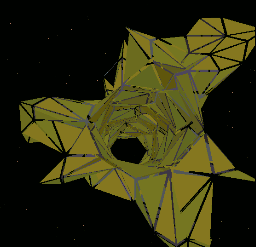Topological Exploration and Analysis of Simplicial Complexes
Using Audio Signals


In this project we explore a new technique for traversing simplicial complexes
(i.e., triangulations or meshes) and
producing sounds from the output of this traversal.
The traversal algorithm was invented in order to extract temporal information
from static geometric structures; this information is used as input to an additive
sound synthesis algorithm.
A systematic traversal of complexes and
associating data to parameters of sound synthesis has many possible applications including
the topological analysis of
objects of dimension 4 or higher, topological exploration of large data sets, and music composition.
In the first phase of our work, which we presented at the
VROOM exhibit at SIGGRAPH '94,
we invented the traversal algorithm and mapped the output of
that traversal in a straightforward way to parameters of an additive synthesis algorithm.
 Click on the icon to
listen to an example of sounds produced in this first phase.
(Note to SGI users: reset the audio output rate to 22 kHz after playing this
8 kHz file.)
It sounds as if it were composed,
and yet it's produced purely from the geometric structure of the data, algorithms, and
output from VSS (VSS is the sound server being developed by the
Audio Development Group, NCSA).
Click on the icon to
listen to an example of sounds produced in this first phase.
(Note to SGI users: reset the audio output rate to 22 kHz after playing this
8 kHz file.)
It sounds as if it were composed,
and yet it's produced purely from the geometric structure of the data, algorithms, and
output from VSS (VSS is the sound server being developed by the
Audio Development Group, NCSA).
In the next phase of our work, which will be presented at
the GII Testbed at Supercomputing '95
in San Diego, we will extend this work in
a number of ways. Users will be given the opportunity to explore large data
sets in real-time by selecting starting points for
exploration, indicating regions of interest, and changing features
of the object under study. To achieve this performance, we must implement
the traversal code on a parallel platform. In addition, we will extend the mapping to
the sound synthesis algorithms with additional parameters, changing timescales,
localization, and multi-layer controls.
References
- U. Axen and I. Choi. "Using Additive Sound Synthesis to Analyze Simplicial
Complexes." Proceedings from the International Conference on Auditory Display,
Santa Fe Institute, 1995.
- P. Fu,
H. Edelsbrunner, U. Axen, R. Bargar, and I. Choi.
"Stepping into Alpha
Shapes." VROOM (Virtual Reality Room) Presentation at SIGGRAPH '94, Orlando, Florida.
Ulrike Axen
Department of Computer Science and
Audio Development Group,
NCSA
University of Illinois
axen@cs.uiuc.edu
Back to top




 Click on the icon to
listen to an example of sounds produced in this first phase.
(Note to SGI users: reset the audio output rate to 22 kHz after playing this
8 kHz file.)
It sounds as if it were composed,
and yet it's produced purely from the geometric structure of the data, algorithms, and
output from VSS (VSS is the sound server being developed by the
Audio Development Group, NCSA).
Click on the icon to
listen to an example of sounds produced in this first phase.
(Note to SGI users: reset the audio output rate to 22 kHz after playing this
8 kHz file.)
It sounds as if it were composed,
and yet it's produced purely from the geometric structure of the data, algorithms, and
output from VSS (VSS is the sound server being developed by the
Audio Development Group, NCSA).